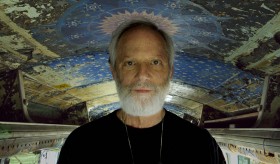Note from Jon Fauer. Andy Romanoff has been king of cranes and remote heads, highly respected Panavision Executive VP of Technical Marketing, and is now managing Industry Relations and Business Development at Abelcine. Andy sent in the following review of “Magic Trip,” directed by Alison Ellwood and Alex Gibney (named by Esquire as “the most important documentarian of our time.”)
“Magic Trip” Film review by Andy Romanoff.
I don’t often advocate for movies, so please forgive my shilling for this one. For reasons not totally clear to me many critics have come down hard on “Magic Bus,” a film about Ken Kesey, the Pranksters and the culture we lived in from 1963-64. I’ve read some of the reviews and they have an attitude that seems a totally unwarranted response to the film I watched. Now, I freely admit I am biased. First, I was a member of the Hog Farm, the commune that came out of the Pranksters. And second, I took my first hit of Nitrous Oxide from a tank that Kesey dragged onto our bus. Finally, I spent time hanging out at the farm with Ken while living in a little cottage in Eugene where one attempt at editing the film was made. So clearly I have a deep emotional connection to the times. But I also love well-made films and I try hard not to be confused by my feelings as I watch what’s on the screen. What I saw at the Nuart doesn’t match up with what some others are writing. So here’s a view of Magic Bus from another perspective.
You may have read mixed reviews of “Magic Trip”, the documentary made from footage shot by the Merry Pranksters on their journey across the country and recounted in “Electric Kool-Aid Acid Test.” Pay no attention and go see the movie. See it for its smart and thoughtful approach, taking the best of forty hours of pretty unwatchable footage and integrating it with audio interviews, animation, readings from transcripts and stock footage to bring one of the signal moments of sixties counterculture alive. All this additional material is necessary because the cameras on the trip were operated by the participants in the story and they had no idea they were making a historic journey. Also, because they were totally inexperienced filmmakers, people on acid filming people on acid much of the footage is….lacking in cinematic qualities. From the Pranksters point of view they were making a documentary of their intense drug fueled road trip to the World’s Fair in New York – they are without any knowledge that their road trip will become a tipping point for a generation and that “Electric Kool-Aid,” the book that comes after, will make this journey familiar to millions.
To witness firsthand the events that become the myth is startling and wonderful, especially because the film becomes witness to the tale, not the other way around. For forty years, we have “known” the story but only through Tom Wolfe’s eyes and he was not there when the events took place. The movie is testament to how good a storyteller he was, how well he captured the drama that developed in the crucible of drugs and journey that the bus ride became. But the thing about Wolfe’s telling is that he knows where it is going as he tells you. The movie does not. The brilliant path taken by Alex Gibney and Alison Ellwood is to let the story unfold without unduly foreshadowing it with the knowledge of how culturally important this journey will become. What they do very well instead is to provide context, weaving Kerouac and Ginsberg, through Cassidy into the story and giving you asides with Leary and Alpert so you know what the Pranksters know at the moment – no more. The film lets you travel on the bus and make the journey as the travelers experienced it. For me it brings the summer of 64 alive and it reminds me of why it was so exciting to be a part of it.
My favorite experiential moment in the film is an audiotape of Kesey as a young man recorded while taking acid in a government-sponsored trial, talking to the tape recorder about his visions while beautiful and fanciful animations transform images of a Wollensak tape recorder. I think Ken would have liked that. In fact, I think Ken would have liked the film very much. During his life, he tried repeatedly to find a path through this material and never succeeded. Perhaps he was to some extent trapped by the distance between the myth created by Wolfe and the concrete images the pranksters brought home. In any case, Gibney and Ellwood have succeeded where others have not and for my money, they have successfully brought the reality of living on the bus to life. If you want a peek at that moment in the sixties when everything seemed possible be sure to see Magic Bus. It really does the job and it has the old hippie’s stamp of approval.









Trippin’ twice with 2 versions of the same article online one after another.
Groovy! Roll another one!
Andy, knowing your history, I can’t think of anyone else on the planet whose opinion I would respect as much on this film. As I think you know, we have traveled pretty parallel paths, socially as well as looking out for the nuts and bolts of how to get people to put cameras in different places. I can’t wait to see Magic Trip. Peace.
Enjoyed your review very much. I’m a big fan of Ken Keseys writing. I met him once in Oregon, and all I can say is, it was really cool. Thanks for taking the time, Andy. Your review seems honest and heartfelt. I’ll catch this one.
Sam Longoria
http://samlongoria.blogspot.com
Hollywood CA USA